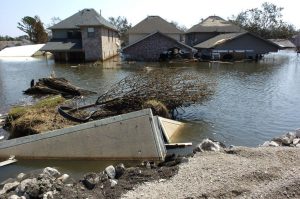Flood Damage Inspections
EMA engineers provide flood damage inspections in Florida, Texas & Louisiana areas. We protect ourself and our clients from the unique challenges posed by flood damaged inspections of damaged buildings.
Hazards in and around flood damage inspections of buildings include the risks of:
- growth of large mold colonies;
- septic system collapse;
- trip-and-fall injuries;
- structural collapse;
- fire and explosions;
- toxic sludge and materials containing waterborne bacteria; and
- electrical shock hazards.

Forensic Flood Damage Inspections
- Inspect the flood damage inspection building exterior for downed power lines and gas leaks. Gas leaks will smell like rotten eggs. If you suspect a gas leak, contact the utility company immediately.
- While entering the building, see if the door sticks at the top. If it does, this could mean that the ceiling is ready to collapse. After you open the door, stand outside the doorway, clear of any falling debris.
- Wear sturdy, treaded boots. According to the American Red Cross, the most common injury following a disaster is cut feet. Broken bottles, nails, glass, and other dangerous debris may litter the floor, and stairs may be very slippery.
- Once you are inside the home, check for gas leaks again by flood damage inspections. If you smell gas or hear a blowing or hissing noise, open a window and quickly leave the building. Turn off the gas at the outside main valve, if you can, and call the gas company from a neighbor’s home. If you turn off the gas for any reason, a professional must turn it back on. Never use an open flame inside of a flood-damaged house unless you know that the gas has been turned off and the house is ventilated. To inspect for damage, use a battery-powered lantern or flashlight, and not an open flame or electrical fixture in the house.
- Do not use appliances that may have gotten wet unless you know they have been dismantled, cleaned and dried.
- Do not work by yourself during flood damage inspections. If you are injured, it might take a long time before you receive assistance. If you must work alone, bring a cell phone or radio so you may call for assistance, if the need arises.
- Bring a HEPA-rated respirator to use in case you detect extensive mold. If you are asthmatic or otherwise at heightened risk to mold exposure, leave the building. Other inspector-safety equipment, such as gloves and coveralls, may also prevent contact with mold and other contaminants.
-
Florida Flood damage Inspections
- Examine doors, walls, windows, floors and staircases to make sure that the flood damage inspections of building shows no signs of potential collapse. Inspect for loose plaster, drywall, and ceilings that may fall. Also, inspect the foundation for evidence of cracks and other structural damage that may render the building uninhabitable.
- Inspect for fire hazards, such as broken and leaking gas lines, flood damage inspections electrical circuits, and submerged furnaces and electrical appliances. Flammable and explosive materials may travel from upstream. Be aware that fire is the most frequent hazard in homes following floods.
- Inspect for electrical system damage, such as broken and frayed wires, and burned insulation. You can turn off the electricity at the main fuse box or circuit breaker. If you have to step in water to get to the fuse box or circuit breaker, call an electrician first for advice. Electrical equipment should be inspected by a qualified professional and dried before being returned to service.
- Inspect for sewage and water supply-line damage. If you suspect sewage lines during flood damage inspections have been damaged, avoid using the toilets and instruct the client to call a plumber before using flood damage inspections. If water pipes are damaged, instruct the client to contact the water utility company and avoid operating the tap.
- Use caution while inspecting crawlspaces for a variety of reasons, such as the presence of mold, sewage, asbestos, chemicals, rodents, and the risk of structural collapse.
- Watch out for animals, especially poisonous snakes, which may have been washed into the building during the flood. You can use a stick to poke through debris to check for dangerous critters.
https://foursquare.com/v/ema-structural-forensic-engineers/59a9bf096f0aa26c32efe3b8
https://www.yelp.com/biz/ema-structural-forensic-engineers-fort-myers
